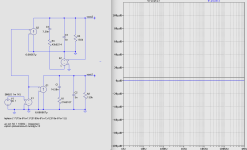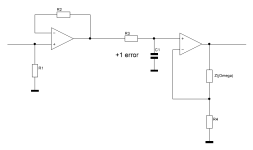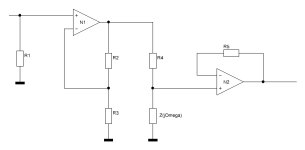It is very good for this thread that we are now slowly all coming to an agreement and having a purely factual discussion.Currently there appears a fundamental misunderstanding of the nature of the comparison.
@Hierfi
Would you like to give a few more explanatory words on a possible comparison so that we can agree on the formalities of a comparison?
I am very pleased that we are finally approaching a consensus in a civilized manner despite the language barrier.
By the term “passive voltage” you mean that a measurable potential difference must first occur (to adjust, adjust alone by himself) , right?Its passive voltage that's the problem, not because the RIAA happens to be active.
So U = I * R, here V = I * |Z| ..!
U means Voltage
A brief interjection:
the last stage of an operational amplifier is often designed as a push-pull output stage, i.e. as an impedance converter.
#
But let's stop counting peas and come to a conclusion. We could use the circuits below as a blueprint. As desired, everything now refers to the reference potential labeled GND or 0V.
Right (may we get started)
?
Attachments
refers to this (following) statement alone, without insisting on the correctness of all given statements.As desired, everything now refers to the reference potential labeled GND or 0V.
One can also speak of “PVE”, the principle of the vanishing input variable.Hopefully clearer, current feeding the inverting terminal from some source is fed back through the RIAA network to set a virtual ground at the inverting terminal. The distinction between active RIAA and passive current RIAA is that the active has a virtual ground and the passive a real ground. This is what the comparison becomes.
E means Input
#
We finally have a starting point.
Perhaps I may also refer to
jamesfeline
wonderful project documentation thread on the current sub-topic (the virtual zero point).
jamesfeline
wonderful project documentation thread on the current sub-topic (the virtual zero point).
But Hierfi, did YOU actually "hear differences"?In arguments specific to the postulate that active RIAA networks are superior to passive RIAA networks is inherent flawed for reasons .... loadsa technical stuff
If you didn't, then it comes down to da technical differences which I'm happy to pontificate at length.
But I'm much more interested in AUDIBLE differences .. though I'm not so naive to expect the results of DBLTs But if no one claims to have "heard differences", there is no need for them. 😊
The cause (of all evil) is ?
because the whole thing is only based on "technical differences", to be precise on the implementation.
👍
And so I assume the resulting AC voltage component of the supply sources (+/-15Vdc) when current is drawn, i.e. under load conditions - is something a party would like to pounce on and rely on.
Please do so,If you didn't, then it comes down to da technical differences which I'm happy to pontificate at length.
because the whole thing is only based on "technical differences", to be precise on the implementation.
👍
And so I assume the resulting AC voltage component of the supply sources (+/-15Vdc) when current is drawn, i.e. under load conditions - is something a party would like to pounce on and rely on.
Last edited:
@kgrleeBut I'm much more interested in AUDIBLE differences
That's the crux of the matter Richard - the question of the differences that we can even process perceptually. We can detect differences in loudness, frequency response deviations, THD, IM and noise. This also results in a certain sensitivity to the so-called group delay distortions. In addition, we can locate sources ("Quellen") acoustically and identify sounds or noises ("Geräusche").
#
Whether there are audible and detectable (assessable) differences? is a prime case for Ethan Winer's null tester.
HBt.
What HiFi, the 'Daily Mail' of hi-fi journalism commenting on a £115 phono preamp. I bet the character that wrote this looked at his blank Word page, look a swig of his cold coffee and thought 'Ahh £$&%, I'll just go for it' and 20 seconds later the review was done without ever having looked or touched the product, let alone any other piece of gear they write about.

A response to this question doesn't have relevance to the proposition presented in post #257. The relevant question is "if differences heard can be attributed to a passive vs. active RIAA?". My assertion is that differences heard cannot be attributed to passive vs active networks for reasons presentedBut Hierfi, did YOU actually "hear differences"?
So the question is what conclusion would you draw if my response was yes? If my response was no? What are looking for to conclude?
In the analysis of passive current RIAA's (being used in my present phono stage), the manner of its behaviour led to a recent investigation into the way RIAA values can be determined. In order to prove the reality of this with more certainty, all active devices were removed that could influence the result in an LTSpice simulation. By implementing this mechanism of calculation the RIAA flatness extended in the uDB levels as indicated in the two examples shown below (note the lines were deliberately shifted by a slight change in the voltage to current translations of G1 and G2 to support the observation).

The manner of calculation uses only two RC time constants, 318uSec and 750uSec, along with a ratio-metric relationship of the actual values specific to capacitors present in those two time constants, whereupon R2C2 = 750usec, R1C1 = 318usec and C1/C2 = 2.916. This empirical conclusion was also verified mathematically by Hans Polak. In my examination of his work... after about 3 seconds my head started to hurt... so I gave up trying to understand it...
Anyway... the upper network is a simplistic variant using the same principles. In this case the inclusion of the voltage/voltage converter E2 generates a unity gain inversion of the present value of the output, hence always increases the value across R4C4 by a factor of 2. As can be calculated the R4C4 time constant remains at 318uSec. The difference being that the magnitude of the ratio of C4/C3 must be reduced to 1/2 previously or to 1.458 to support the flatness.
As mentioned somewhere before, by the inclusion of physical voltage/voltage amplifier this permits selection of standard values of capacitors to be used, that in conjunction with resistors to support the 318uSec time constant can easily be tuned for flatness, or alternatively support potentiometric variabilty of tuning around the 500Hz pole by about +/- 2dB in the present implementation.

The manner of calculation uses only two RC time constants, 318uSec and 750uSec, along with a ratio-metric relationship of the actual values specific to capacitors present in those two time constants, whereupon R2C2 = 750usec, R1C1 = 318usec and C1/C2 = 2.916. This empirical conclusion was also verified mathematically by Hans Polak. In my examination of his work... after about 3 seconds my head started to hurt... so I gave up trying to understand it...
Anyway... the upper network is a simplistic variant using the same principles. In this case the inclusion of the voltage/voltage converter E2 generates a unity gain inversion of the present value of the output, hence always increases the value across R4C4 by a factor of 2. As can be calculated the R4C4 time constant remains at 318uSec. The difference being that the magnitude of the ratio of C4/C3 must be reduced to 1/2 previously or to 1.458 to support the flatness.
As mentioned somewhere before, by the inclusion of physical voltage/voltage amplifier this permits selection of standard values of capacitors to be used, that in conjunction with resistors to support the 318uSec time constant can easily be tuned for flatness, or alternatively support potentiometric variabilty of tuning around the 500Hz pole by about +/- 2dB in the present implementation.
As passive voltage the 2.916 was also confirmed mathematically in the following:
http://waynestegall.com/audio/riaa.htm
http://waynestegall.com/audio/riaa.htm
I have known Wayne Stegall's website for ages - and yet I have no idea (glue) what you are trying to tell us.As passive voltage the 2.916 was also confirmed mathematically in the following:
http://waynestegall.com/audio/riaa.htm
Could you please express yourself more correctly in technical terms or use other means of description than just the written word.
Thank you.
Good,(...) My assertion is that differences heard cannot be attributed to passive vs active networks for reasons presented (...)
because that's what the egg dance was all about.
So we agree that (in our context) it makes no difference whether a trivial filter function is realized “actively” or “passively”. From the point of view of the functional equation, both forms are the same.
If you were to answer negatively, then the commercial audio wheel would stop turning - and humanity would have to look for another topic of discussion and waste its energy elsewhere.So the question is what conclusion would you draw if my response was yes? If my response was no? What are looking for to conclude?
However,
if you were to answer in the affirmative, then we could investigate further and get to the bottom of the matter. We would still be productive.
Do you answer the question in the affirmative? Can you identify differences between two typical representatives (apparently) hearing?
If a clear yes confirms all of this and is supported by a second opinion, then one of the two representatives is not doing their job correctly!
#
It's as simple as that. The closer the alignment, the more equal both parties have to be.
HBt.
PS
Do we want to continue this thread or move on to another field? In my opinion, this thread will not lead to any real results in the foreseeable future.
😢
Very good,In the analysis of passive current RIAA's (being used in my present phono stage), the manner of its behaviour led to a recent investigation into the way RIAA values can be determined. In order to prove the reality of this with more certainty, all active devices were removed that could influence the result in an LTSpice simulation. By implementing this mechanism of calculation the RIAA flatness extended in the uDB levels as indicated in the two examples shown below (note the lines were deliberately shifted by a slight change in the voltage to current translations of G1 and G2 to support the observation).
I see what you are doing (and that was never the point, because this circuit possibility is known, we went through these forms in our studies before the operations - but that's another story, I'm getting old), I like this diversity.
Now everything is finally clear to me, a clear view.The manner of calculation uses only two RC time constants, 318uSec and 750uSec, along with a ratio-metric relationship of the actual values specific to capacitors present in those two time constants, whereupon R2C2 = 750usec, R1C1 = 318usec and C1/C2 = 2.916. This empirical conclusion was also verified mathematically by Hans Polak. In my examination of his work... after about 3 seconds my head started to hurt... so I gave up trying to understand it...
You made my day.
Would you like to show us your finished circuit?
@Hierfi
if I find all these findings in the article by Hans P. whose rights are held by Jan D., then I will buy all the material - I have a right of return with Amazon, which I would exercise after reading it if the content does not absolutely promise what it should.
Have a nice day, I had a girlfriend from Roxton Falls Quebec long time a ago ...
HBt.
Sorry,
but "you made my day".
"Und ich danke Dir dafür sehr herzlich". And I thank you very much for this. I can now finally correctly categorize all the posts that seemed very strange to me.
Now we are finally making progress in the usual RIAA threads.
thx,
HBt.
but "you made my day".
"Und ich danke Dir dafür sehr herzlich". And I thank you very much for this. I can now finally correctly categorize all the posts that seemed very strange to me.
Now we are finally making progress in the usual RIAA threads.
thx,
HBt.
If you said 'Yes. I am the one who heard the differences".A response to this question doesn't have relevance to the proposition presented in post #257. The relevant question is "if differences heard can be attributed to a passive vs. active RIAA?". My assertion is that differences heard cannot be attributed to passive vs active networks for reasons presented
So the question is what conclusion would you draw if my response was yes? If my response was no? What are looking for to conclude?
First we check if you can hear this reliably ie via DBLTs.
Then if this is a reliable result,
the investigation moves to your two cases to see if we can find the reason(s) for this difference.
If you said "No. I am not the one who heard the difference", we would apply the above test to the person who heard the difference and their two cases.
If you said "No. I am not the one who heard the difference. My wife's hairdresser said her husband is a HiFi Golden Pinnae and can hear anything and everything". ie someone we have difficulty applying the test to, we conclude this is not worth pursuing.
Note it's only the last case where we reach a conclusion. In the first two cases, the question is only the start of the investigation.
Forgive me for asking again but ...My assertion is that differences heard cannot be attributed to passive vs active networks for reasons presented
What are the reasons you attribute these audible differences to? We'll assume our DBLTs show these differences are reliably detected 😉
htbaudio, what hierfi is saying is his RIAA network is so supa accurate that only an idiot would question it 😊
Last edited:
When will my species finally be allowed to get to the bottom of this (hopefully purely technical) circumstance?If you said 'Yes. I am the one who heard the differences".
First we check if you can hear this reliably ie via DBLTs.
Then if this is a reliable result,
the investigation moves to your two cases to see if we can find the reason for this difference.
And by definition, the endless loop no longer has an exit option, unless we simply terminate this investigation after n interviews. But in the near future, someone will be found who will take up the test again and be the first to look for suitable test participants.If you said "No. I am not the one who heard the difference", we would apply the above test to the person who heard the difference and their two cases.
That's a damn good decision.If you said "No. I am not the one who heard the difference. My wife's hairdresser said her husband is a HiFi Golden Pinnae and can hear anything and everything". ie someone we have difficulty applying the test to, we conclude this is not worth pursuing.
You've summed up the basic rules of procedure in a nutshell and we don't need to say any more about it.Note it's only the last case where we reach a conclusion. In the first two cases, the question is only the start of the investigation.
HBt.
Fundamentals
If the scene were not characterized by flirtatious secrecy, but by openness, then one could explore the exciting field of all (real) sciences with an honest heart.
In our case, it is more fruitful to unapologetically post a complete circuit, because it is readable.
As long as one hide behind hints, one are leading DIY by the nose.
A question @Hierfi :
How should the MM cartridge be considered, as a kind of voltage source or as a kind of current source, it is not an ideal source - so how and how should it be terminated?
Perhaps this is where the dog is buried?!
HBt.
If the scene were not characterized by flirtatious secrecy, but by openness, then one could explore the exciting field of all (real) sciences with an honest heart.
In our case, it is more fruitful to unapologetically post a complete circuit, because it is readable.
As long as one hide behind hints, one are leading DIY by the nose.
A question @Hierfi :
How should the MM cartridge be considered, as a kind of voltage source or as a kind of current source, it is not an ideal source - so how and how should it be terminated?
Perhaps this is where the dog is buried?!
HBt.
- Home
- Source & Line
- Analogue Source
- RIAA Overload Performance’ to Encoded Signals (i.e. the Music) and Response to Clicks and Pops (Unencoded)

